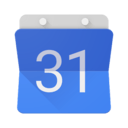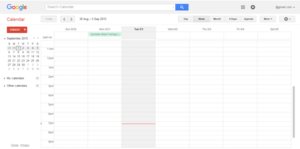Google Calendar
 | |
|
Screenshot  | |
| Developer(s) | |
|---|---|
| Initial release | April 13, 2006 |
| Written in | Java[1] |
| Operating system | Server: Linux |
| Type | Electronic calendaring |
| License | Freeware |
| Website |
www |
Google Calendar is a time-management web and mobile application created by Google. It became available on April 13, 2006, and exited the beta stage in July 2009. Users are required to have a Google Account in order to use Google Calendar, however the mobile app supports synchronising with 3rd party calendar services.
Features
Interface
The interface of Google Calendar, designed by Kevin Fox,[2] is similar to desktop calendar applications such as Microsoft Outlook or iCal on Mac OS X. The Ajax-driven interface enables users to set the number of days to show in their custom view mode. Stored online; consequently, the calendar can be viewed from any location that has Internet access. For users who might experience a hard drive failure, it also means that no data is lost. The application can import Microsoft Outlook calendar files (.vcs) and Comma-separated values (.csv), as well as Webcal links.[3] Users can modify, add, and drag-and-drop events from one date to another without reloading the page. It supports view modes such as weekly, monthly, and agenda. Users can "quick add" calendar events by typing standard English phrases, such as "Dinner with Michael 7 p.m. tomorrow". Users can also set the number of days to show in their custom view mode.
Content access
Events are similar to desktop calendar applications such as Microsoft Outlook or iCal on Mac OS X. The Ajax-driven interface enables users to view, add, and drag-and-drop events from one date to another without reloading the page. It supports view modes such as weekly, monthly, and agenda. Users can "quick add" calendar events by typing standard English phrases, such as "Dinner with Michael 7 p.m. tomorrow". Users can also set the number of days to show in their custom view mode.stored online; consequently, the calendar can be viewed from any location that has Internet access. For users who might experience a hard drive failure, it also means that no data is lost. The application can import Microsoft Outlook calendar files (.vcs) and iCalendar files (.ics, the de facto open calendaring file format). Multiple calendars can be added and shared, allowing various levels of permissions for the users. This enables collaboration and sharing of schedules amongst groups. General calendars available for importing into one's account include those containing national holidays of various countries. Users can also add "live" iCalendar URLs that update regularly.[4]
Sharing calendars
Google Calendar allows multiple calendars to be created and shown in the same view. Each can be shared, either read-only or with full edit control, and either with specified people or with everyone (public calendars). In February 2009, Google discontinued the option of searching for public calendars from the search field by removing the "Search Public Events" button. It also disabled its public calendar gallery,[5] citing maintenance and usability issues. The company suggests adding calendars via the "Interesting Calendars" feature, known calendar URLs, or via email requests to friends. Daily "To Do" tasks cannot currently be shared between users.
Device synchronization
Currently, Google Calendar can use Google Sync to synchronize with many mobile devices (e.g., BlackBerry, Palm, iPhone, Pocket PC) or with PC applications (e.g., Microsoft Outlook) via third party software, and natively with Apple's iCal (workarounds required for iCal 3.x, full functionality with iCal 4.x).[6] Google Calendar is natively supported on Android-based smartphones and tablets, webOS-based mobile phones such as the Palm Pre and iOS devices such as the iPhone.[7] Event reminders can be sent via email, as well as via SMS to mobile phones in more than eighty countries and regions.
Google integration
Google Calendar is integrated with other Google services:
- Gmail, Google's webmail service. When an e-mail that contains trigger words (such as "meeting", or dates and times) arrives, an "add to calendar" button is automatically displayed alongside it.
- iGoogle, the user-designed Google homepage, in which users could choose and organize content in the form of 'gadgets'. The calendar was shown as a module on one's homepage. This "gadget" offered options to edit how the time is displayed, which day the week starts on, and a link to "Add Event".[8] iGoogle was discontinued on November 1, 2013.[9]
- Google Desktop, Google's desktop search software for Windows or Mac OS X. The mini-calendar gadget allowed one to view their agenda without having to open their browser. One could place it on their desktop or leave it docked in the sidebar.[8] Google Desktop was discontinued in September 2011.[10]
2009 introduction
On March 4, 2009, Google Calendar began offering offline support.[11] On May 13, 2009, Google Calendar began offering to-do lists,[12][13] via Google Tasks.
Compatibility
Because Google Calendar is a web-based application, it is accessible from virtually any operating system, provided that the OS has a browser which supports the required web technologies. Since it uses recent browser features, browser compatibility includes Microsoft Internet Explorer 6 or higher; Mozilla Firefox 2+; Opera 9+; Google Chrome; and Safari 2+.
Google Calendar supports exporting calendar data through a permanent HTTP URL containing iCalendar data, either at a public or "private" (hard to guess) address. This bears resemblance to the Webcal "protocol". Public calendars were searchable until February 2009. The data can be integrated with, among many others, Novell Evolution,[14] and Windows Calendar in Windows Vista (using the subscribe feature). The web link for the location of the calendar can be found in Google Calendar Settings in the Private Address section.
Google Calendar also supports CalDAV using iCal 3.x.[15] Google announced in March 2013 that CalDAV would be limited to "whitelisted" developers only, and other developers would be limited in the future to Google Calendar API.[16]
Consistency and reliability
As in other cloud computing applications, changes to Google Calendar are immediately visible to all users. This allows new features to be added without user action, but also makes it possible for new bugs to be rolled out to the entire user population, without users being able to refuse the update. On March 18, 2010, an update to add the Smart Rescheduler feature[17] caused problems such as automatic invitations to nonexistent users being generated for events that were edited in secondary calendars.[18] Despite negative user feedback, Google chose not to roll back the update, concentrating instead on providing a fix. According to user reports, the fix took effect five days later, on March 23, 2010.
Other criticisms
Many users of Google Calendar criticized the inability for time zones to be handled correctly in the application,[19][20][21][22] as well as Google's unwillingness to resolve the issue.[23] Until December 2010, there was no way to associate a time zone with the start/end times of a particular event. Because of this, users experienced problems when attempting to schedule events outside of their current time zone. In early December 2010, Google implemented a partial fix, allowing events to be associated with time zones, but it remained unable to display events each in their own time zone, like a travel itinerary does.[24]
Google Calendar does not support "tentative" dates and times for events,[25] which may cause synchronization problems with Microsoft Outlook.
When viewed on PC browsers such as Internet Explorer or Firefox, Google Calendar cannot show the contents of the 'Description' field without entering the 'Edit' page for that event. Even expanded Agenda view does not allow viewing of this field. This makes it impossible to know which items have had any 'Description' added to them short of clicking 'edit' for every single event one by one. Forums suggest hundreds of users have highlighted this failure for several years.[26]
Month view is designed to fit on a single printed page. The downside to this is that it lacks text wrapping to see the full appointment title. Many users have complained about this.[27] A workaround is to use another application to convert Google Calendar data to a format with full support for text wrapping.[28]
See also
References
- ↑ Neal Gafter explains how Google Calendar (written in Java) could use Closures Advanced Topics In Programming Languages: Closures For Java
- ↑ Lenssen, Philipp. "Kevin Fox of Gmail & FriendFeed on User Experience Design - Google Blogoscoped". blogoscoped.com. Retrieved 2009-05-29.
- ↑ https://support.google.com/calendar/answer/37118
- ↑ Westfall, Jon. "Add Facebook Friend's Birthdays to your Calendar Automatically". JonWestfall.Com. Retrieved 2012-08-02.
- ↑ Archived March 3, 2009, at the Wayback Machine.
- ↑ "Google Sync for your phone". Google.com. Retrieved 2012-08-02.
- ↑ Google Calendar for iPhone. It's about time. Google. March 10, 2015.
- 1 2 Google Calendar Gadget
- ↑ Sandeep Shawn-Tripathy (September 8, 2012). "Say Goodbye To iGoogle". topnettools.com. Retrieved April 26, 2014.
- ↑ Alan Eustace (September 2, 2011). "A fall spring-clean". Google. Retrieved April 26, 2014.
- ↑ "Official Gmail Blog: View Google Calendar offline". Gmailblog.blogspot.com. Retrieved 2012-08-02.
- ↑ "Official Gmail Blog: Tasks, now in Calendar too". Gmailblog.blogspot.com. Retrieved 2012-08-02.
- ↑ Stan Schroeder 82 (2009-05-13). "Google Calendar Adds Tasks". Mashable.com. Retrieved 2012-08-02.
- ↑ Google Calendar in Evolution
- ↑ Google Calendar, CalDAV support using iCal.
- ↑ , A Second Spring of Cleaning.
- ↑ Smart rescheduler in Google Calendar Labs
- ↑ Google Calendar help forum thread: Calendar prompting invites to guests when I don't want them.
- ↑ Community-powered support for Google
- ↑ Android Guys, Fix Google Calendar!
- ↑ Washington Post, Google Calendar's time zone weakness
- ↑ PC World: Is Google Calendar Timezone-Challenged?
- ↑ Calendar Swap
- ↑ Official Gmail Blog Event time zones in Google Calendar
- ↑ "Google Discussiegroepen". Google.com. Retrieved 2012-08-02.
- ↑ https://productforums.google.com/forum/#!topic/calendar/630CnJQQj1Y
- ↑ "Google Discussiegroepen". Google.com. Retrieved 2012-08-02.
- ↑ "Google Discussiegroepen". Google.com. Retrieved 2012-08-02.